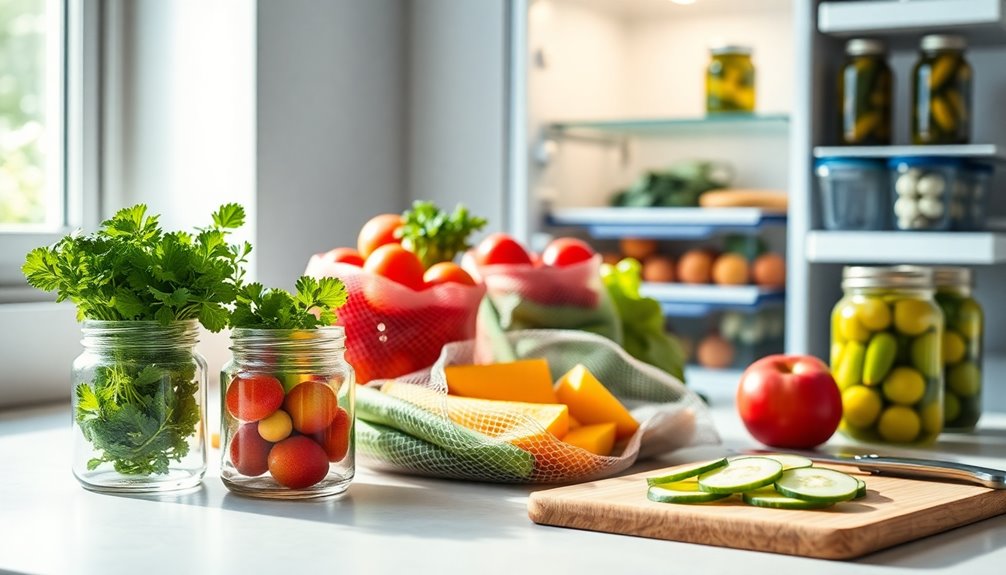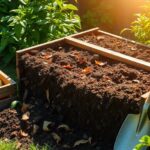To maximize food freshness and reduce waste, you should master proper storage techniques. Keep your refrigerator between 32°F and 40°F and use airtight containers to protect pantry items from moisture. Store fruits and vegetables in the crisper drawer, while meats and dairy belong on the cooler lower shelves. For long-term preservation, freeze foods using airtight bags or containers, labeling them with dates for easy access. Regularly check your pantry and fridge for expired items, following a first-in, first-out method. By incorporating these strategies, you can maintain freshness and minimize waste, ensuring food stays delicious longer—there's more to discover!
Key Takeaways
- Keep your refrigerator temperature between 32°F and 40°F to slow down spoilage and extend food freshness.
- Store fruits and vegetables in the crisper drawer to maintain optimal humidity and prevent spoilage.
- Use airtight containers for pantry items to protect against moisture and pests, preserving freshness longer.
- Label frozen items with dates and contents to track freshness and use the "first in, first out" method.
- Regularly check for expired items in your pantry and refrigerator to reduce waste and keep food organized.
Understanding Food Spoilage
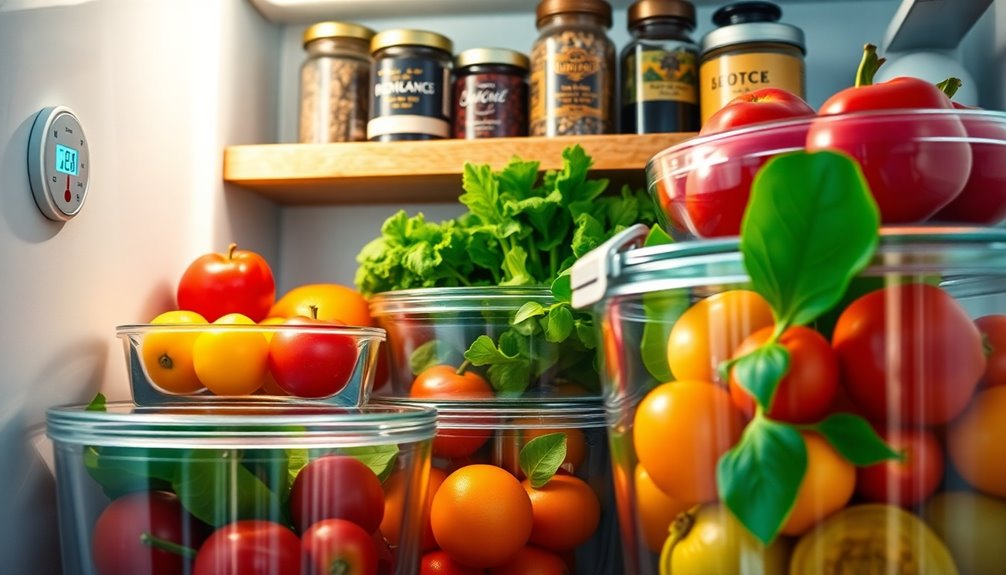
Food spoilage is a natural process that happens when microorganisms, enzymes, and environmental factors interact with perishable items. Understanding the reasons for spoilage can help you make informed decisions about food storage. Common reasons include bacteria, mold, and yeast, which thrive in moist environments. Enzymatic reactions, often accelerated by heat, can also lead to deterioration. Recognizing these factors is vital to prevention.
To keep your food fresh, it's important to identify the signs of spoilage. Look for changes in color, texture, and odor. For example, if fruits or vegetables develop dark spots or a slimy texture, they're likely past their prime. Similarly, if meat smells sour or has an off color, it's best to discard it. Being vigilant about these signs can help you avoid unwelcome surprises.
There are effective solutions to combat spoilage. Proper storage techniques play an important role. Make sure that your food is stored in airtight containers to minimize exposure to air and moisture. Additionally, keeping your refrigerator at the right temperature can slow down microbial growth. It's also wise to organize your pantry and fridge, placing older items in front to encourage usage before they spoil. Incorporating a plant-based diet can also help reduce waste by utilizing ingredients efficiently and promoting the use of fresh produce.
Best Practices for Refrigeration
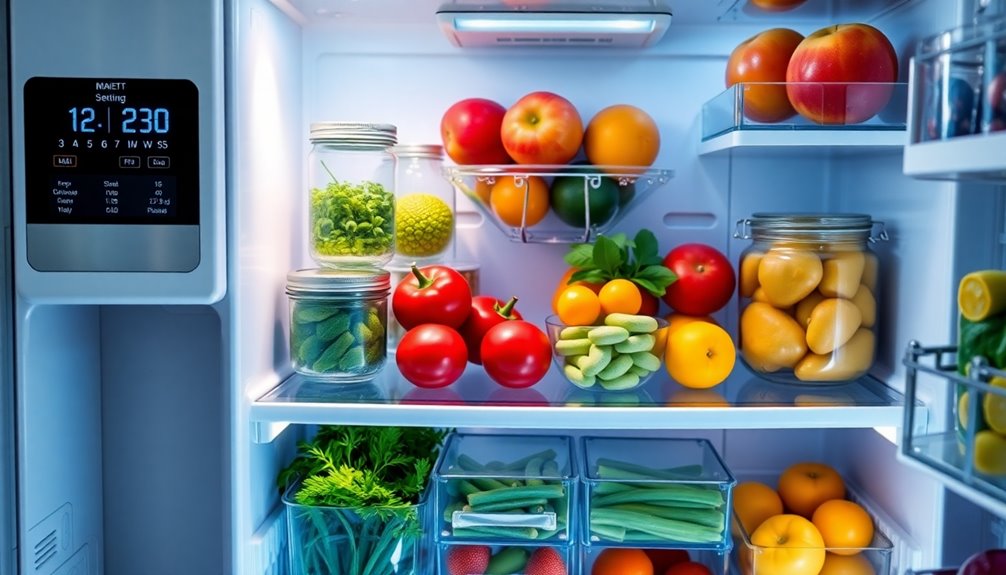
When it comes to maximizing freshness, knowing how to properly refrigerate your food is crucial. First, focus on temperature control. Your refrigerator should ideally be set between 32°F and 40°F (0°C to 4°C). This range slows down bacterial growth and helps maintain the quality of perishable items. Regularly check the temperature with an appliance thermometer to guarantee your fridge stays within this prime range.
Next, let's talk organization tips. Place items strategically to maximize airflow and keep everything cool. The back of the fridge is usually the coldest spot, making it perfect for storing dairy products and meats.
Reserve the middle shelves for ready-to-eat items like leftovers and drinks, while the crisper drawers are ideal for fruits and vegetables. Remember to wrap or seal items tightly to prevent moisture loss and odors from mingling.
Don't forget to label your food with dates. This simple practice not only helps you use items within their freshness window but also minimizes waste. Regularly check your fridge for expired items and incorporate a "first in, first out" approach to use older products before newer ones. Additionally, staying hydrated with SlimCrystal bottles can help improve your overall health and vitality while you manage your food storage.
Optimal Pantry Storage Techniques
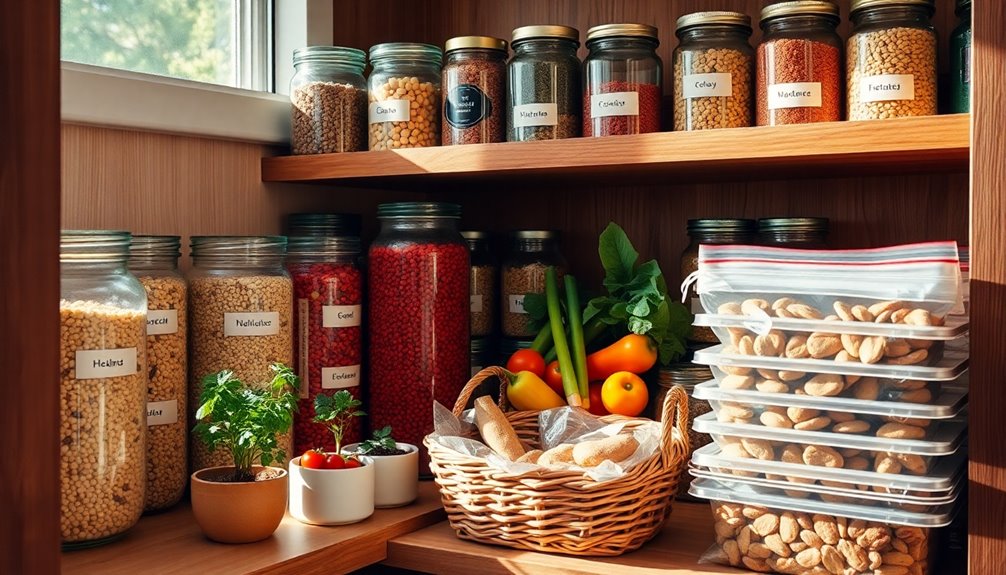
Proper pantry storage methods are essential for keeping your dry goods fresh and extending their shelf life. To maximize freshness, start with effective shelf organization. Group similar items together, such as grains, canned goods, and snacks. This not only makes it easier to locate what you need but also assists in pantry rotation.
Always use the "first in, first out" method: place newer items behind older ones, ensuring you consume the older products first to minimize waste.
Utilizing airtight containers is vital for maintaining the quality of your pantry staples. These containers prevent moisture and pests from spoiling your food. Choose transparent containers so you can easily see what's inside, enhancing your shelf organization. Label each container with the contents and date of purchase to keep track of freshness.
Temperature control is another crucial aspect of pantry storage. Store your pantry in a cool, dry place, away from heat sources like ovens or direct sunlight. Fluctuating temperatures can compromise the integrity of your food, leading to spoilage.
Lastly, regularly check your pantry for expired items and reorganize as needed. A well-maintained pantry not only cuts down on waste but fosters a sense of belonging in your kitchen. You'll feel more connected to your cooking and meal prep processes, knowing that your ingredients are fresh and ready to use. By implementing these best pantry storage methods, you're taking a significant step toward reducing waste and enhancing your culinary experience. Additionally, proper storage techniques can also help in maintaining the freshness of food over time, just as mini bands do for effective muscle toning.
How to Freeze Food Effectively
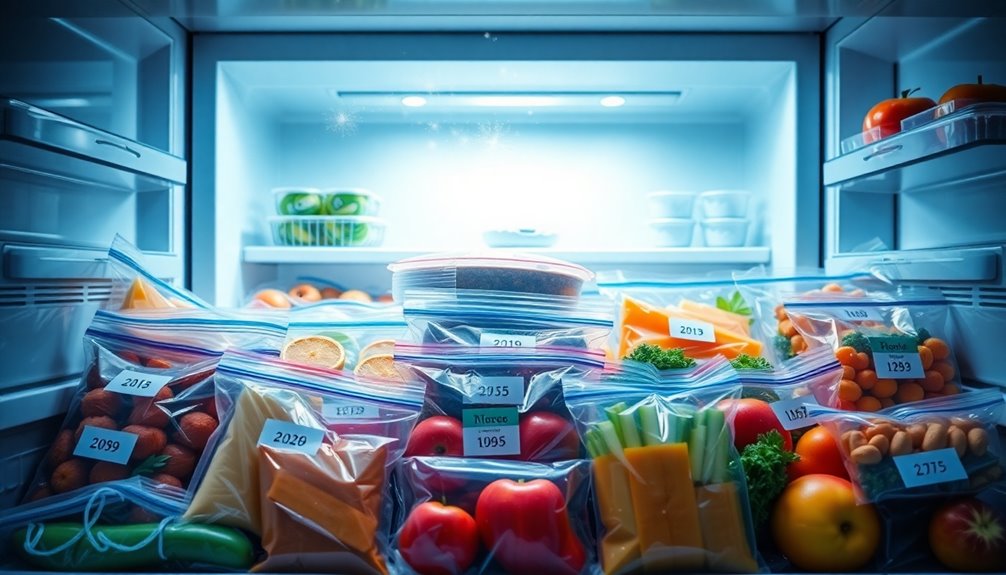
Freezing food efficiently can greatly extend its shelf life while preserving flavor and nutritional value. To reap the benefits of freezing, you need to focus on proper packaging and freezer organization. If done correctly, you can minimize waste and guarantee you always have delicious meals ready to go.
Here are three key strategies to freeze food effectively:
- Use Airtight Containers or Freezer Bags: Choose containers specifically designed for freezing or heavy-duty freezer bags. These help prevent freezer burn and maintain your food's freshness. Remove as much air as possible from bags before sealing.
- Label Everything: Always label your packages with the contents and date. This simple step will help you keep track of what you've frozen and make sure you use older items first, reducing waste.
- Organize Your Freezer: Group similar items together, such as meats, vegetables, and prepared meals. This organization makes it easy for you to find what you need, saving time and avoiding food from being forgotten in the back. Additionally, consider utilizing the art of hand sharpening to enhance your kitchen skills, ensuring that your knives are always ready for meal prep.
Storing Fresh Produce Properly
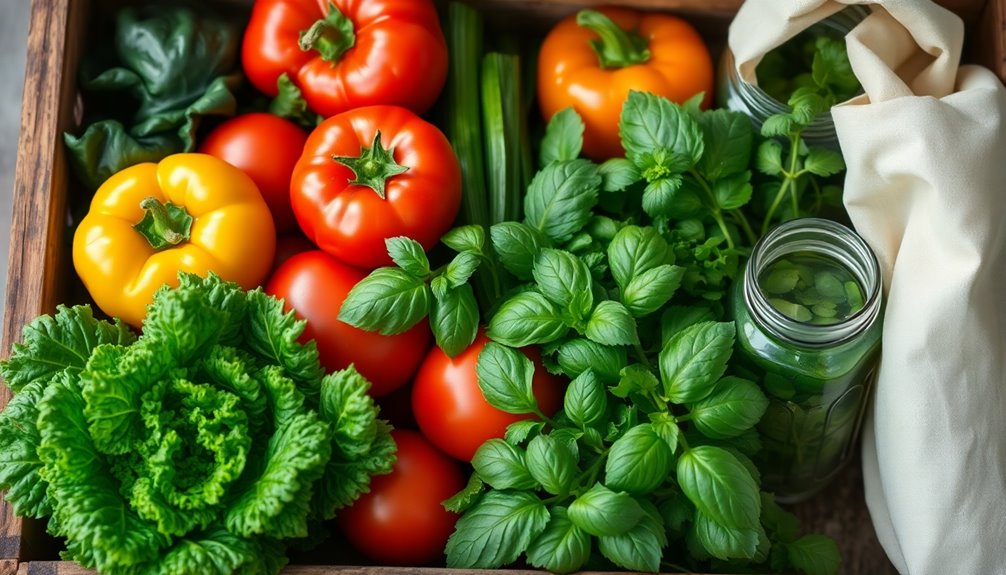
Storing fresh produce effectively can greatly enhance its longevity and quality. To do this, understanding the role of humidity control and ethylene sensitivity in preserving your fruits and vegetables is vital. Different types of produce have varying needs; some thrive in high humidity, while others prefer drier conditions.
For example, leafy greens and herbs appreciate a moist environment, so store them in breathable containers or wrapped in damp paper towels. Conversely, root vegetables like potatoes and onions should be kept in a cool, dark place with low humidity to prevent spoilage.
Ethylene sensitivity is another essential factor. Certain fruits, such as bananas, apples, and avocados, emit ethylene gas, which can accelerate ripening in nearby produce. If you want to keep your strawberries or broccoli fresh for longer, store them away from ethylene-producing fruits. You might consider using separate bins or drawers in your refrigerator, or even designating specific shelves for ethylene-sensitive items.
When you prepare your produce for storage, make sure to inspect for any bruised or damaged pieces, as these can lead to quicker spoilage. Incorporating homemade vegan smoothies into your diet can also help utilize produce that is nearing its expiration date. A little attention to detail can go a long way. By following these guidelines on humidity control and ethylene sensitivity, you create an environment that nurtures your fresh produce, ensuring that you enjoy every bite while reducing waste. This not only benefits your meals but also helps foster a sense of community around sustainable eating practices.
Repurposing Leftovers Wisely
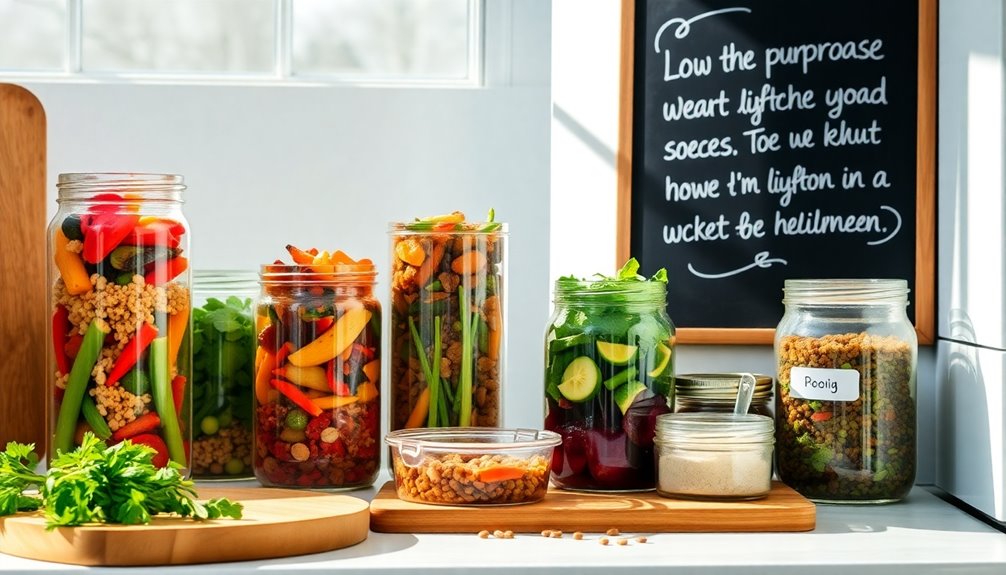
Maximizing the freshness of your produce doesn't stop at the refrigerator; it extends to how you handle leftovers as well. You can transform yesterday's meals into exciting new dishes that not only reduce waste but also enhance your week's meal planning. Embracing creativity in the kitchen allows you to enjoy your leftovers in unique ways. Here are three ideas to get you started:
- Make a Stir-Fry: Use leftover vegetables and proteins to whip up a quick stir-fry. Toss them in a hot pan with some soy sauce and spices for a nutritious meal in minutes.
- Create a Frittata: Combine leftover meats and veggies into a delicious frittata. Just beat some eggs, add your leftovers, and bake or cook on the stovetop. It's a perfect breakfast or brunch option.
- Craft a Soup: If you have a variety of leftover ingredients, consider making a hearty soup. Simply simmer them in broth, season to taste, and you've got a comforting meal that's easy to prepare. Additionally, utilizing leftovers helps combat the common issue of weight loss complications, making meal prep less stressful and more enjoyable.
Tips for Reducing Food Waste

Reducing food waste is essential for both environmental sustainability and your wallet. By implementing a few strategic habits, you can minimize waste while still enjoying delicious meals.
One effective method is meal planning. Take a little time each week to outline your meals, considering what ingredients you already have and what you need to buy. This approach not only helps you avoid impulse purchases but also guarantees you use up ingredients before they spoil.
When you create your shopping list, stick to it. This discipline prevents overbuying, which often leads to forgotten produce languishing in the back of your fridge. Additionally, keep an eye on expiration dates and organize your pantry so that older items are more accessible.
Another smart practice is composting leftovers. Instead of tossing scraps and unwanted food in the trash, set up a composting system. This not only reduces the waste you send to landfills but also creates nutrient-rich compost for your garden. Implementing these habits can also support overall wellness, as maintaining a healthy lifestyle is key in managing conditions like Chronic Kidney Disease.
If composting isn't feasible, consider creatively repurposing leftovers into new dishes, making sure nothing goes to waste.
Frequently Asked Questions
How Do I Tell if Food Is Still Safe to Eat?
To determine if food's still safe to eat, start by checking the expiration dates. If it's past that date, it's best to be cautious.
Next, perform a smell test; if it smells off, don't risk it.
Look at the color and texture too—anything that's changed noticeably could indicate spoilage.
Trust your instincts; when in doubt, throw it out. Your health's worth more than a questionable meal.
Can I Store Different Food Types Together?
Storing different food types together can seem convenient, but it poses cross-contamination risks. To maintain best storage conditions, keep raw meats separate from fruits and vegetables, as bacteria can easily transfer.
You'll also want to pay attention to temperature and humidity levels, ensuring each type of food thrives in its preferred environment.
What Containers Are Best for Food Storage?
When it comes to food storage, you'll want to ponder vacuum sealing and glass containers. Vacuum sealing removes air, extending your food's freshness, while glass containers are sturdy and easy to clean.
Opt for BPA-free, airtight options to guarantee your food stays safe and uncontaminated. These choices not only preserve quality but also foster a sense of belonging, as they help you maintain a clean and organized kitchen that you can be proud of.
How Can I Prevent Freezer Burn on Foods?
Think of your freezer as a treasure chest; you want to keep your food jewels safe from the elements. To prevent freezer burn, wrap items tightly in plastic wrap or use airtight containers, ensuring no air slips in. This method helps in preventing food spoilage and extends shelf life, allowing you to enjoy your meals longer.
Regularly check your freezer's temperature, ideally at 0°F, to keep your treasures in pristine condition.
Should I Wash Fruits and Vegetables Before Storing?
You should wash fruits and vegetables before storing them, but it's important to think about proper washing techniques. Washing removes dirt and pesticides, but excess moisture can lead to spoilage. Make sure you dry them thoroughly to maintain best moisture levels.
If you wash them before storage, use a paper towel to absorb any remaining moisture. This way, you enhance freshness while minimizing waste, making your food prep not only efficient but also enjoyable.
Conclusion
By implementing these storage techniques, you'll not only maximize freshness but also become a food-saving superhero in your kitchen! Understanding spoilage, optimizing refrigeration, and mastering pantry organization can dramatically reduce waste. Properly storing fresh produce and freezing food effectively guarantees you get the most out of your groceries. Plus, repurposing leftovers creatively keeps meals exciting. Remember, every bit of food you save is a small victory against waste—so start making these changes today!

